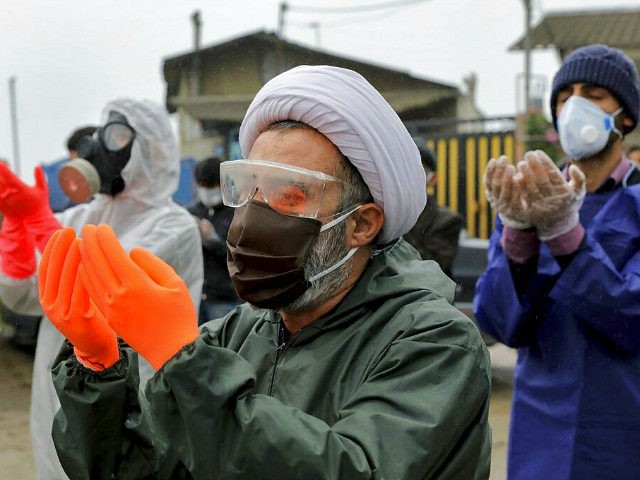The deputy health minister of Iran, Iraj Harirchi, said on Monday that the current Chinese coronavirus death rate in Iran could mean that as many as 200,000 people in the country are contracting the virus every day.
Experts have long derided Iran for putting together one of the world’s worst responses to the Chinese coronavirus, failing to prevent mass indoor events for Islamic holidays, among other regime festivals, as the virus began spreading out of China in February. Iranian officials have also repeatedly touted dubious developments like a “magnetic” coronavirus detector, a vaccine developed by the state terrorist organization, the Islamic Revolutionary Guard Corps (IRGC), and rapid coronavirus tests that allegedly work better than those in developed countries.
The IRGC has not updated the public in months on its alleged coronavirus vaccine and the government has announced plans to buy a Chinese vaccine candidate, calling into question early claims of the jihadist group developing such a medical marvel.
Harirchi himself, then the head of Iran’s coronavirus task force, became a symbol of the failed coronavirus response in the country when he appeared on television in February to assure the nation that the local outbreak was under control. Viewers noted that Harirchi appeared sickly and feverish and officials confirmed that he had contracted the virus less than a week later. The virus then rapidly spread among elite members of the Iranian Islamic regime.
Around 10,000 Iranian health workers have tested positive for the Chinese coronavirus, the regime-aligned Iranian Labour News Agency quoted the country’s deputy health minister as saying on Thursday. https://t.co/76m8HzjzBh
— Breitbart News (@BreitbartNews) May 22, 2020
Harirchi made his shocking estimate on Monday in remarks carried by the Iranian state newspaper Hamshahri, according to the National Council of Resistance of Iran (NCRI), the country’s most prominent opposition group.
“For each Covid-19 [Chinese coronavirus] death, 200 to 1000 people have contracted the virus,” Harirchi reportedly explained. “This means if the country has 400 coronavirus deaths in one day (similar to the current daily coronavirus deaths in Iran) there is an average of 200,000 new cases per day.”
The Iranian government at press time has documented 880,542 Chinese coronavirus cases nationwide since the pandemic began there in late January and 45,738 deaths. If Harirchi’s estimate is accurate, Iran would reach its official total number of cases documented throughout ten months in about five days.
“There is no country in the world able to find all the positive cases,” Harirchi reportedly asserted.
Iran’s official coronavirus numbers have been the subject of much skepticism since the pandemic began. The NCRI, which has been keeping its own death toll using information from informers at hospitals, cemeteries, and other institutions, claimed on Monday that it has documented 165,200 deaths in the country in total, more than three times the official number. That number tracks with the findings of the World Health Organization (W.H.O.) in March, which stated that it believed about five times the number of people had died in the country at the time than those the regime documented.
Supreme Leader Ayatollah Ali Khamenei implemented a nationwide lockdown in the country on Saturday in an attempt to slow the spread of the disease.
“As per the new measures, travel to and from high-risk cities are banned and a night ban on movement keeps streets empty from 9 p.m. to 4 a.m.,” the state-run propaganda outlet PressTV reported. The ban affects 150 cities and the regime will fine violators. President Hassan Rouhani announced an alleged economic aid package to those affected by the lockdowns, though it is not yet clear what that package will consist of.
Iran’s parliament heard Wednesday the fatality rate from the coronavirus pandemic is likely nearly double officially reported figures. https://t.co/Mm50gzNV5e
— Breitbart News (@BreitbartNews) April 16, 2020
The Iranian economy has largely collapsed after years of the regime spending millions on wars in neighboring countries. Following the windfall of sanctions relief in the era of President Barack Obama, Tehran invested heavily in defending Syrian dictator Bashar al-Assad and aiding the Shiite Houthi jihadist movement in Yemen. Iran also established a destabilizing presence in Lebanon and Iraq and has expanded its influence on the other side of the world in Venezuela.
Following the restoration of sanctions under President Donald Trump, meant to limit Iran’s terrorist behavior, revenue to the regime plummeted. Instead of investing the limited resources in the Iranian economy to benefit citizens, Iran has attempted to maintain its influence in its neighbors, leading to a collapse in the value of the national currency, the rial, and extreme inflation making it difficult for citizens to buy basic items such as eggs and milk.
The Iranian regime announced in June that it had lost $92 billion in revenue in the fiscal year preceding 2020.
Khamenei used remarks on Tuesday to call sanctions on the regime a “crime” and ordered his underlings to “overcome” them however they could. Iranian officials have repeatedly insisted that sanctions are the reason for their failed coronavirus response, not mismanagement on their part. On one rare occasion, the Iranian Health Ministry blamed China for the crisis in the country, claiming that they used China’s official numbers to plan for hospital capacity and that Beijing’s data was a “bitter joke.”
The Chinese coronavirus originated in Wuhan, China.
Follow Frances Martel on Facebook and Twitter.

COMMENTS
Please let us know if you're having issues with commenting.